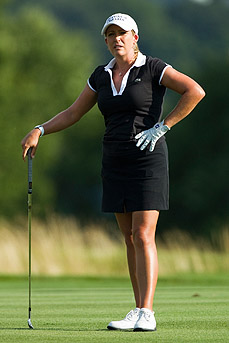Oakmont, Pa. – The difficulty of Oakmont Country Club is the worst-kept secret in golf.
Playing 36 holes a day is one of the game’s great challenges.
Put them together and the result is … well, not something tasty like mixing chocolate and peanut butter to create the Reese’s Cup.
I can’t think of a tougher grind than 36 holes out here, said Meaghan Francella, who endured exactly that number of holes Saturday in the 65th U.S. Women’s Open.
Friday’s suspension of play due to inclement weather created further challenges for a field that already had its hands full with the
omnipresent difficulty of Oakmont. Ninety-eight of the 156 players did not get to complete their second round, and 24 players hadn’t hit a shot when the day was washed out.
Cristie Kerr only had to play 13 holes on Saturday, but struggled with three double bogeys. (John Mummert/USGA)
That meant that some players, like Francella, went around Oakmont twice on Saturday.
Double the fun. Double the frustration.
My legs are kind of wobbly. I’m pretty tired, the New York resident said after shooting a third-round 77 on top of an earlier 1-over 72. I mean, it’s definitely tougher out there on you mentally than physically, but yeah, it’s not an easy walk either. It really tests you all the way around.
That’s what players were saying about 18 holes at Oakmont. Additional holes just meant additional challenges.
It’s warm out, it’s a tough walk, and the fact that you have to really focus on every single shot just wears you out, said Morgan Pressel, who played 32 on Saturday and completed a 4-over 75, then came back with another 75 later in the day. I got here at 6 a.m., and definitely it affected me playing that many holes. I made some poor decisions and they’ve cost me.
Perhaps one of the players who had it the toughest was Allison Fouch, who was in the final group off the 10th tee in Round 2 and then had 30 minutes before turning around and venturing back out in the first threesome for Round 3. She shot 74, and followed it up with an 80.
At least I didn’t have to warm up again, Fouch said with a shrug and a tired chuckle. I didn’t play well, but some players are doing OK, so I just didn’t roll with the challenges.
The long day Saturday is not necessarily out of the ordinary. Both men and women are routinely asked to play more than 18 holes because of weather delays or in amateur competitions conducted at match play. Four years ago, the women faced a 36-hole final day in the U.S. Women’s Open at Newport (R.I.) Country Club won by Annika Sorenstam, who needed an additional 18 holes on Monday to defeat Pat Hurst in a playoff.
Even the leader, Paula Creamer, who was one under through 13 holes in the third round after playing 16 holes earlier in the day, wasn’t exactly chipper despite her good play. Of course, she hadn’t played much golf this year because of a left-thumb injury.
It [her thumb] is tired. My whole left hand is pretty tired. That's to be expected, Creamer said. I haven't played this much golf, jeez, since last year. And, you know, I had two warm-ups. I played just a lot of golf today, and, you know, the previous days, as well.
You know, today was a tough day. I got here at 5:30 this morning, and it's 9 now. That's a lot of golf. On this golf course, I mean, 18 holes is hard enough, let alone how many we played today. I just kept telling myself, just keep making pars, hitting the middle of the greens, stay below the hole.
And stay patient, of course.
Patience really is a huge thing, Alexis Thompson said after she shot an impressive third-round 70.
Indeed, Oakmont is one of the toughest championship tests in the world, and players know they have to hang in there and trade punches with it the best they can.
I let the golf course beat me up, Fouch said. You can’t do that. You just can’t let your guard down, no matter how tired you are.
Let that happen and it leaves a bad taste in your mouth.
Dave Shedloski is a freelance writer whose work has previously appeared on USGA websites.
